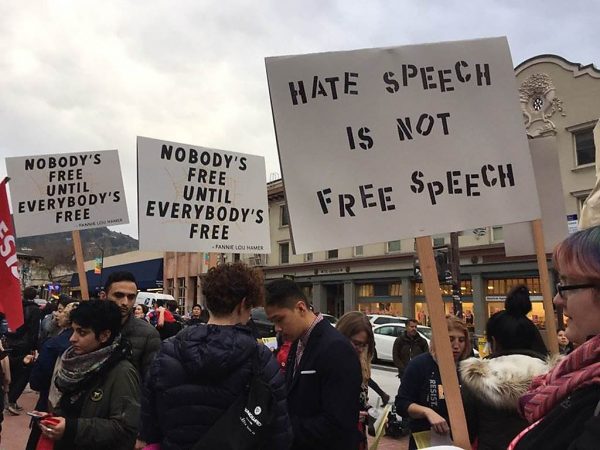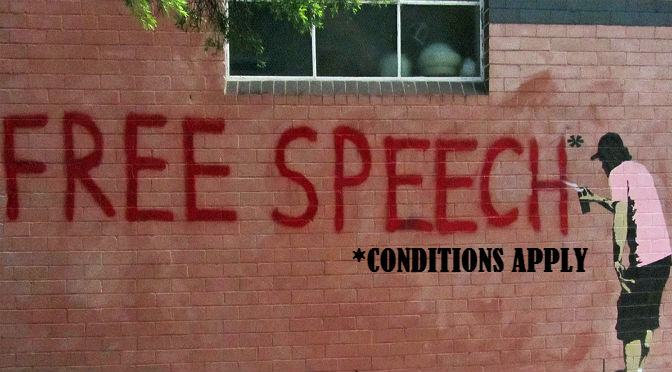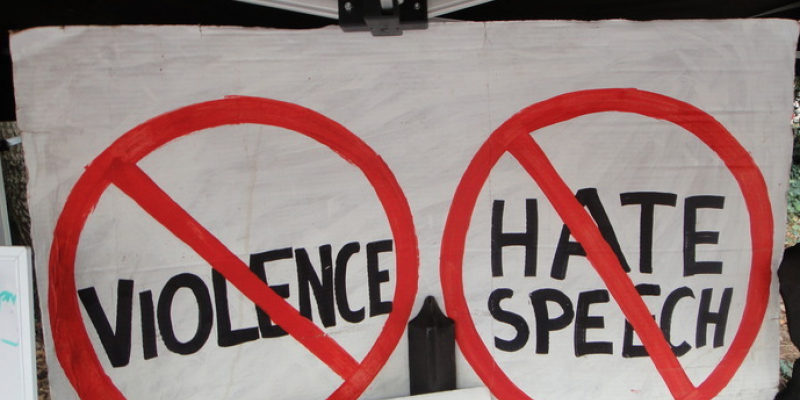Anti-discrimination regulations are their own kind of soulcraft.
How the Ultra-Left Wins

Conservatives and liberals alike let them do it.
Arthur Milikh’s account of hate speech activism may be chalked up as one more sky-is-falling panic that will prove just as empty as every other right-wing alarm we have heard over the years. We were told that same-sex marriage would devastate domestic morals in America, but Obergefell did no such thing. Pat Buchanan’s hysterical convention speech in 1992 only showed that social conservatives were insecure enough to think that the slightest challenge to “family values” means the downfall of the West. They still are.
I could go on, but why bother? The regularity with which false alarms such as Milikh’s come along is getting ridiculous. It hardly needs to be said that prudent and considerate boundaries placed around extreme forms of verbal harassment is not an assault on basic freedoms. C’mon.
So goes the liberal would-be rejoinder to Milikh’s warning. You see his dilemma. Milikh outlines calls for hate speech reform that will eventually erode legal protections for free speech. It’s a “powerful, multi-front movement” that operates to a great extent outside the realms of litigation. In courtrooms, anti-hate speech advocates have to make arguments and compile evidence and prove critics of hate speech laws wrong. A forensic contest takes place and judgments follow. But such contests don’t take place beyond the courtroom or in Silicon Valley, higher education, and the administrative state (through offices such as the Equal Employment Opportunity Commission).
Larry Summers at Harvard, James Damore at Google, Jack Phillips when he stood before the Colorado Civil Rights Commission: all these cases illustrate well the absence of debate. The accusers don’t rebut; they denounce. It’s an obvious move. Why spend time on substance when you have the power to set the agenda and punish dissenters? You don’t argue if you don’t have to.
And so we may anticipate the reply to Milikh should liberals in those zones ever pay attention: “What’s the big deal?”
It comes not from hard leftists such as the ones Milikh quotes in the essay, but from their more numerous liberal colleagues. The hard Left is, in fact, a minority even in the institutions that favor some form of hate-speech regulations, but that doesn’t curb their enthusiasm.
Readers of The American Mind who labor in academia have seen the dynamic unfold again and again. A department of 20 professors has three identity politicians in the mix who push leftist policies such as quotas in faculty hiring and graduate admissions. The other 17 professors vote Democrat, sympathize more or less with feminism, and favor a mild form of affirmative action. Quotas, they believe, go too far. But the intensity with which they hold those moderate views doesn’t come close to the intensity of the three.
The balance of passion falls on the side of the minority, and it shows up in their outsized influence on department policy. The 17 liberals don’t wish to oppose the goals of the leftists in admissions and hiring; they only want to soften the methods. They accept the principle—diversity, equity, etc.—but doubt the procedures.
As the discussion proceeds, leftists mount an ardent plea for more social engineering of incoming personnel. Liberals answer with notes of caution. After all, while group identity has come to dominate academic thinking, liberals still feel some lingering commitment to judging people as individuals, not as representatives. (In the old days, this was termed “stereotyping.”)
But the sentinels of the old guard know, too, how the winds have changed, and they’ve witnessed the punishments old-school liberals have suffered when they opined too strongly against the campus Left. As the faculty meeting progresses, a compromise is reached—not one which reflects the 17-to-3 split, however.
The leftists have managed to draw the moderates closer to their side than their numbers warranted. The faculty won’t establish a quota, but when the applications arrive, they’ll start by checking the demographics of each. (A neat demonstration of this tendency is Cass Sunstein’s 1999 paper “The Law of Group Polarization.”)
This happens over and over. In my experience, when it comes to policy matters, the leftists have shown three times the stamina of their colleagues. They are firm; moderates are squishy. Incrementally, steadily, almost without liberals realizing it (or wanting to realize it), the orientation of the department swings to port.
Twenty-five years ago, liberal academics would have been appalled by the prospect of segregated graduations. Now, those ceremonies happen at Harvard, UCLA, and Stanford without a whisper of dismay. The identity politicians have won.
The Real Post-Modernists
Milikh demonstrates well that this same drift is happening in the hate speech controversy. Liberals and leftists often speak of “normalization,” the process whereby a social or political conception, condition, or practice comes to be accepted as ordinary and natural. Almost always, the critique aims to subvert a “normality” that hinders the advance of progressive politics, such as “heteronormativity.”
But, as is also usually the case, in reality the leftist critique applies best to what leftists themselves do. There is no institution more ripe for a Foucauldian analysis of power, surveillance, and bureaucratic control than the soft parts of higher education. Here, before our very eyes, is the normalization of radical conceptions of language and pain—the language of “violent speech” installed as Gospel—and it has made extraordinary progress.
When Toni Morrison stated in her Nobel Prize acceptance speech in 1993, “oppressive language does more than represent violence; it is violence,” not many scholars and teachers would have gone along with that confusion. Few today would dare to dispute it openly.
Anti-hate speech activism is a particular problem for liberals because free speech is a cornerstone of liberalism. Compared to the overturning of the First Amendment, affirmative action looks like but a tiny compromise of liberal principles. The implications of the ideas put forward by those whom Milikh cites are drastic. It is necessary for liberals, then, to frame his reaction to hate-speech designs as an overreaction to a paper tiger.
Liberals cannot do otherwise. The Left has cajoled and nudged and pressured them into an untenable position. They don’t want to anger the Left, and they would rather not acknowledge that they have participated in illiberal policymaking. Denial is the only response.
I have heard that liberal shrug a hundred times. It has been the standard response to allegations of liberal bias on campus: “Sure, there’s some of that, but not much.” The examples Milikh raises—Professor Matsuda who wishes to criminalize speech that contains “messages of inferiority” to “historically disadvantaged groups”—the liberal will concede but diminish. If you said to him, “But that could make merely addressing the wide test score gap between blacks and whites an offense worth investigating,” he would assure you that such a step wouldn’t follow.
You can imagine, too, the measured moderate responding to the one-sidedness of hate-speech theory (it protects historically-disadvantaged groups alone): “Well, yes, but do white males really need protection when they are so overrepresented in elite jobs?” Or when the definition of hate widens so much as to take in a dumb joke in a Facebook post: “Okay, but the pendulum will swing back.” Or when Milikh questions the “New Dignity” and the liberal answers, “You don’t want to rob people of dignity, do you?”
Gaslighting
All this is merely a new iteration of what Marcuse called “repressive tolerance.” Milikh is granted his point, but only 10% of it. He isn’t wrong about there being a problem with hate speech laws, they say, but he really, really exaggerates it. An abuse may occur here and there, a zealous official may go too far in enforcement, but every regulation poses dangers. That doesn’t mean we should scrap the whole thing. We handle those abuses as they come.
This, to me, is the salient impact of Milikh’s paper. Conservatives who work in those spheres he mentions have seen enough deterioration of free speech to need no convincing. His presentation does, however, reveal something about another group—not the radicals pushing hate-speech restrictions but the liberals watching and letting them do it. As Milikh describes the activism, we imagine at the same time the moderate onlookers who won’t get in the way. We have witnessed the liberal institutions which those more circumspect personalities manage become ever more open to illiberal designs, and we know it shall continue.
The trend is now so obvious that one can’t understand why the conservative leadership in America has proven so ineffectual in resisting it.
How many Republicans have wilted in the presence of those “brittle human beings” (Milikh’s term) whom identity politics has primed for hypersensitivity, as we saw when those two angry women pinned Senator Flake in the elevator? How many conservatives have swallowed the phony rhetoric of “tolerance and inclusion,” as another bygone Republican, Gerald Ford, did in his August 1999 New York Times op-ed entitled “Inclusive America, Under Attack,” blaming opponents of affirmative action for extending the “cultural and social impoverishment that afflicted my generation”?
And how disappointingly have they acted in the cultural sphere, as when Senator Bob Dole and Secretary James Baker pressed Frank Gehry’s abominably anti-traditional design for the Eisenhower Memorial on the Mall? (Baker did secure some positive changes to the design, but it’s still a disaster).
The challenge is clear. Milikh mentions “at least two possible outcomes” awaiting America: “despotism if ‘hate speech’ advocates fully have their way or rebellion if they do not.” The liberal leadership has no plan to deal with either one. Neither does the Establishment Right. The rising right-of-center leadership must learn the lesson. Hate-speech radicals are not going to stop, and the liberals who run the institutions are not going to stop them. What are conservative politicians, churchmen, businessmen, foundation heads, and professionals going to do about it?
The American Mind presents a range of perspectives. Views are writers’ own and do not necessarily represent those of The Claremont Institute.
The American Mind is a publication of the Claremont Institute, a non-profit 501(c)(3) organization, dedicated to restoring the principles of the American Founding to their rightful, preeminent authority in our national life. Interested in supporting our work? Gifts to the Claremont Institute are tax-deductible.
The securitization of so-called hate speech.
It’s time for a counter-revolution in moral rhetoric.
A call to action.




